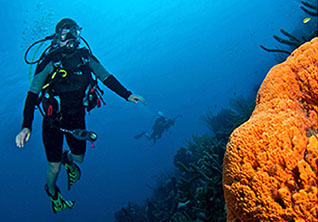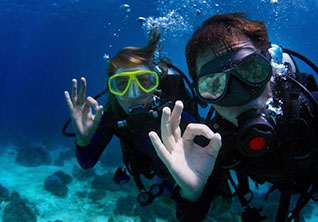The Cuttlefish: The Undisputed Master of Camouflage.
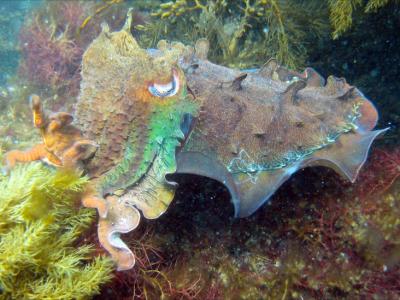
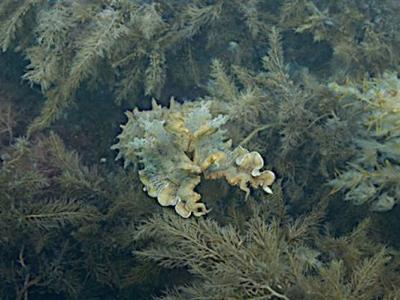
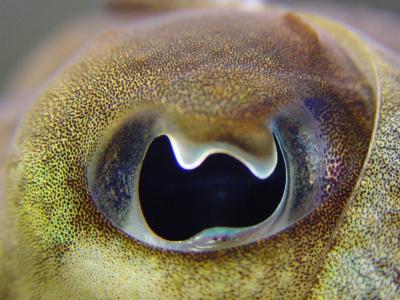
Off the shores of every ocean except around the Americas hovers one of most ingenious creatures in the world. The Cuttlefish can blend in with almost any natural substrate and most divers will swim unknowingly right by them as they appear to look like a clump of seaweed, a rock, or a patch of gravel. To begin with, they are not a fish, but a member of the phylum Mollusca along with snails and bivalve clams. The word “cuttle” may have come from the Old Norse word for “soft”. They are in the same class Cephalopoda as octopus, squids, and the nautilus. They have eight arms and two elongated tentacles similar to squid and in the middle of that ring of arms is a parrot like beak. They also have a unique internal porous plate called the cuttlebone. The purpose of this porous aragonite plate is similar to a scuba divers “BC”, buoyancy compensator, and the cuttlefish can change its buoyancy with just a little addition or subtraction of gas or fluid within the cuttlebone. You may have seen cuttlebones at a nearby pet store where they are sold as calcium enriched nibble treats for birds such as parakeets. So, while the squid flies just under the surface, and the octopus hugs the bottom or hides in dens, the cuttlefish is hovering over the substrate like a mysteriously color changing oblong shaped flying saucer in search of its next close encounter with shrimp, fish, or crab. They may be near shore in Australia or Indonesia, or found down to depths of 600m (2000ft) elsewhere. Apparently, below this depth their gas filled cuttlebone may implode, so great depth and cold waters may be the biggest reasons why they haven’t already invaded the Americas.
A couple of other things we should quickly mention is that they have three hearts. They use two of the hearts just to pump blood to their gills as they use hemocyanin, a bluish green copper protein, to carry oxygen around and this is less efficient than the rich red colored iron based hemoglobin that we use. The third heart pumps blood to the other parts of their body. Like the squid and octopus, they can squirt out a dark or brown ink that gives them a cloud to hide behind and may as well momentarily affect some predator’s sense of smell.

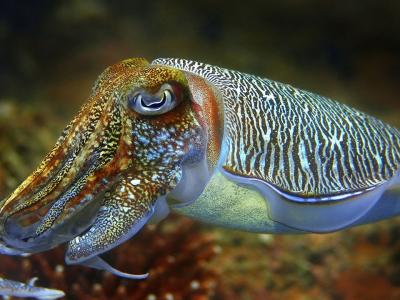
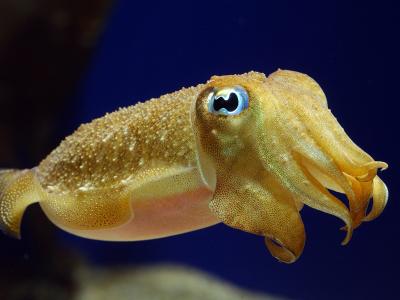
Lastly, we have to mention the eyes and brain. The eyes are shaped like squiggled W’s and have two concentrated sensor spots called foveae on each eye; one of the spots concentrated on light forward of the body, and the other sensor spot on light emitted behind the body. The eyes have no blind spot such as those found in human eyes, and they can even perceive polarized light as well as low levels of light, and without their eyes they can use their lateral lines to hunt in complete darkness. Their eyes may be considered quite advanced in so many aspects, but for the record, the cuttlefish is colorblind. They are constantly looking for visible cues such as light intensity, contrast, polarization, background patterns, and substrate textures. They have one of the largest brain to body mass ratio sizes in the invertebrate kingdom and some scientists believe cuttlefish are similar in intelligence to vertebrates such as pigeons and mice. In laboratories they can run simple maze tests and can be conditioned to learning at least two conditional rules to be used at the same time; such as looking for secondary signs in order to determine the best routes to escape through pipes, or be taught to tap on objects to receive food rewards.
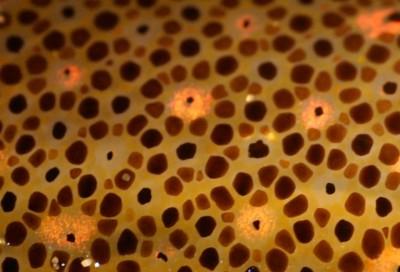
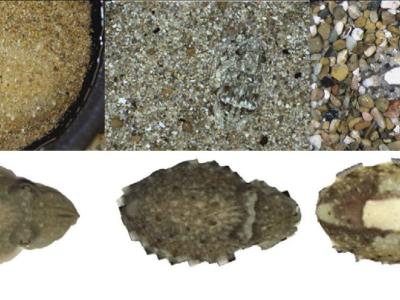
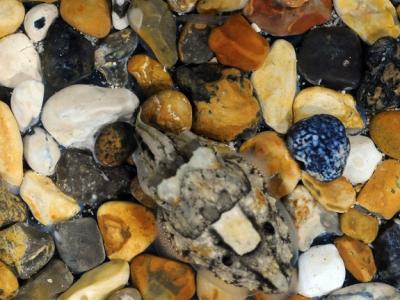
On the basic level, their brain takes in the surrounding visual cues and as quick as lightning sends signals out to their seemingly electric skin to change color, patterns, and/or skin texture. Cuttlefish need use only one of three distinguishing methods to make themselves appear invisible. With small backgrounds such as sand, they use a uniform pattern and they blend in by appearing as a collection of sand particles. For certain sized gravel rocks, they use a mottle pattern and they appear with larger colored areas that replicate as a group of rocks. The third method called disruptive, is used not to blend in with the background, but to disrupt or break apart their own body outline so that potential predators don’t recognize their natural body outline against underwater backgrounds, boulders, or large checkerboard backgrounds such as tested in marine labs. Add to this pattern coloration or different light intensities from forming different colors across their skin and you have a very stealthy and deceptive predator/prey species. Now add their ability to use muscular rings to pump up and transform regional skin tissues into bumps, blades, spikes, and leaflets, and you have what could be easily mistaken as an alien species.
To take a closer look at how they make their bodies change colors we only have to go skin deep. Just beneath the skin are layers of elastic sack cells containing different pigment colors, and commonly referred to as chromatophores. First we find yellow, then red, then deeper down brown pigmented chromatophores. Each chromatophore can reduce in size or increase in surface size by 500% merely by pulling on or relaxing their surrounding muscle cords. Below these chromatophores reside a layer of iridescent emitting and reflecting cells of the colors blue, green, red, and pink. Below this layer are leucophores, cells that reflect all colors of light at once, or what we commonly refer to as white light. It appears to be a highly complicated eye to brain to skin activity, but cuttlefish can change color in some twenty million pigment cells in mere split seconds and still have extra brain power left to use for other evolving applications.
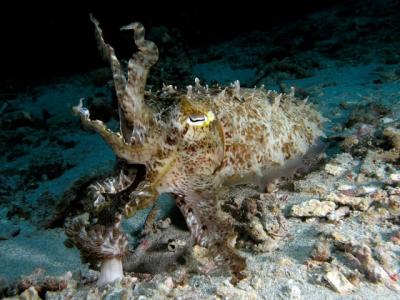
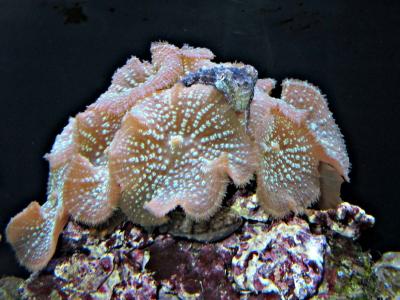
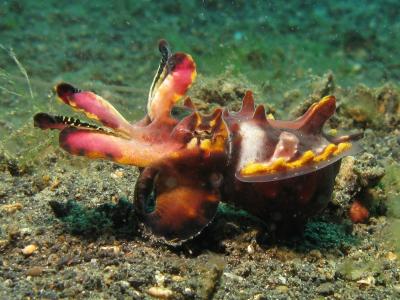
Besides camouflage, cuttlefish use their skin to communicate with each other including using locomotion indicators such as hovering, sitting, jetting, and postures such as arm position and, placement as well as fin shape, and head tilting. In Broadclub cuttlefish, smart smaller males have learned to appear as non-sexually receptive females to move without impunity around larger males guarding potential female mates. They can do this with such skill that the side of their body facing larger potential male rivals appears female in appearance while the side facing potential females partners they flaunt their male side and hence display to the female how clever they really are. While large males are allowed to mate with females some 30% of the time, the clever cross dressing smaller males are allowed to mate some 60% of the time and thus their learned ability to go covert or in duel disguise is successfully rewarded by receptive females over time and their abilities are more successfully propagated through each generation.
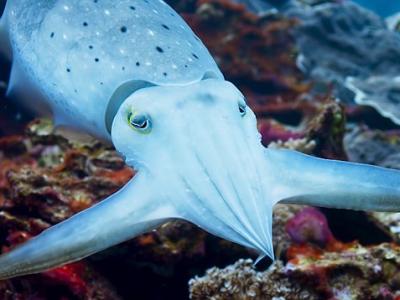
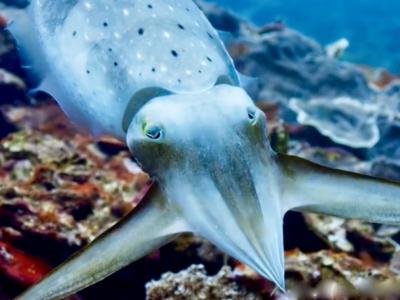
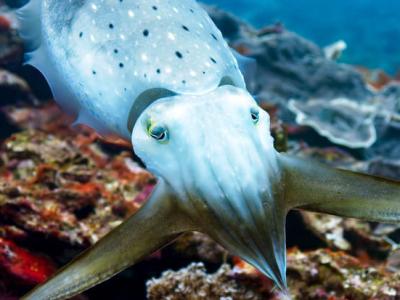
Another adaptive use of Broadclub cuttlefish is their ability to have waves of light appear to ripple across their head and arms which seems to hypnotize crabs while the cuttlefish prepares to strike from the best strategic angle, so as not to get pinched from the crab’s claws while bringing the crab into contact with their beak.

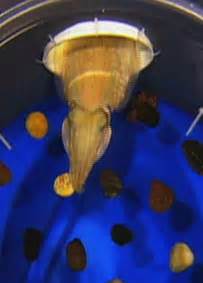
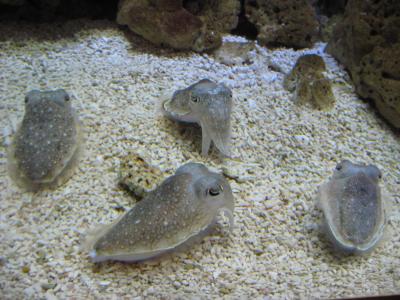
One species can use their colors to worn off predators or go one step farther as to highlight a yellow fringed warning color that they are poisonous such as the little Flamboyant cuttlefish who prefers to walk across the bottom of muck and rarely swims. They are the only cuttlefish known to be poisonous, and the poison is in their muscles, and perhaps as potent as the poison of the blue ring octopus. The fact that they walk similar to a lobe fin fish and have a reduced size cuttlebone could lead to a new evolutionary direction for this species. The fact that cuttlefish only live two years at most, have such a large amount of brain power, and have persisted in the fossil record since the Cretaceous times, shows that these rather unusual soft bodied aliens have the right stuff to keep on evolving and becoming even smarter and more diverse over time: that is, if sharks, fish, dolphins, seals, and humans don’t eat them all first.

Recent Posts
- Eastern Malaysia, Sabah, Sipadan & More
- Ghost Pipefish, Pipefish, Seahorses, and Sea Dragons
- Australia Queensland and the Great Barrier Reef
- Tioman Islands, Malaysia
- The Riviera Maya
- The Peter Diving System
- The Bay Islands, Roatan, Utila, Guanaja, and more.
- The Cuttlefish; The Undisputed Master of Camouflage.
- The Maldives: A Garland of Islands in the Indian Ocean
- Frogfish, The Overlooked Camouflage Artist
Categories
- Australia
- Bahamas
- Bay Islands
- Belize
- Blue Hole
- Bonaire Diving
- Borneo
- Cayman Brac
- Cayman Islands
- Cozumel
- Curacao
- Cuttlefish
- Dive Destinations
- Dive Equipment
- Dive Liveaboards
- Dive Resorts / Properties
- Dive Travel
- Dive Travel Deals
- Diver Wellness
- Dolphins
- Dominica
- eagle rays
- Eagle Rays
- Family Travel
- Fiji
- Galapagos Islands
- Great White Shark cage diving
- Guanaja
- Honduras
- Indonesia
- Infographics
- Isla Mujeres
- Learning to Dive
- Little Cayman
- Maduro Dive Newsletter
- Malaysia
- Maldives
- Manta Rays
- Marine Life
- Mexico
- Micronesia
- Muck Diving
- Myamar
- Palau
- Papua New Guinea
- Pelagics
- Philippines
- Pinnacles
- Polynesia
- Reefs
- Riviera Maya
- Roatan
- Saba
- Sabah
- Scuba Diving
- Scuba Gear Reviews
- Scuba News/Events
- Scuba Training & Education
- Sea Legends
- sea lions
- Sea of Cortez
- Sharks
- Single Travel
- Sipadan
- Socorro Islands
- South Africa
- Specialties
- ST. Kitts
- Stingrays
- Tahiti
- Thailand
- The Bucket List
- Tobago
- Truk Lagoon (Chuuk)
- Turks and Caicos Islands
- Turtles
- Uncategorized
- Underwater Photography
- Underwater Video
- Utila
- Walls
- Whale Sharks
- Whales
- Wreck Diving
- Wrecks
- Yap
Archives
- January 2024
- April 2023
- March 2020
- March 2019
- January 2019
- November 2018
- September 2018
- July 2018
- May 2018
- March 2018
- January 2018
- October 2017
- September 2017
- June 2017
- April 2017
- February 2017
- January 2017
- October 2016
- August 2016
- July 2016
- May 2016
- March 2016
- February 2016
- January 2016
- December 2015
- August 2015
- June 2015
- April 2015
- January 2015
- November 2014
- July 2014
- April 2014
- February 2014
- December 2013
- November 2013
- October 2013
- September 2013
- August 2013
- July 2013
- June 2013
- May 2013
- April 2013
- March 2013
- February 2013
- January 2013
- December 2012
- November 2012
- October 2012
- September 2012
- August 2012
- July 2012
- June 2012
- May 2012
- April 2012


